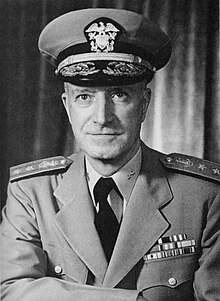William Sterling Parsons
| William Sterling Parsons | |
|---|---|

Rear Admiral William S. Parsons
|
|
| Nickname(s) | "Deak" |
| Born |
26 November 1901 Chicago, Illinois |
| Died | 5 December 1953 (aged 52) Bethesda, Maryland |
| Place of burial | Arlington National Cemetery |
| Allegiance |
|
| Service/branch |
|
| Years of service | 1922–1953 |
| Rank |
|
| Battles/wars | |
| Awards |
Navy Distinguished Service Medal Silver Star Legion of Merit |
Rear Admiral William Sterling "Deak" Parsons (26 November 1901 – 5 December 1953) was an American naval officer who worked as an ordnance expert on the Manhattan Project during World War II. He is best known for being the weaponeer on the Enola Gay, the aircraft which dropped the Little Boy atomic bomb on Hiroshima, Japan in 1945. To avoid the possibility of a nuclear explosion if the aircraft crashed and burned on takeoff, he decided to arm the bomb in flight. While the aircraft was en route to Hiroshima, Parsons climbed into the cramped and dark bomb bay, and inserted the powder charge and detonator. He was awarded the Silver Star for his part in the mission.
A 1922 graduate of the United States Naval Academy, Parsons served on a variety of warships beginning with the battleship USS Idaho. He was trained in ordnance and studied ballistics under L.T.E. Thompson at the Naval Proving Ground in Dahlgren, Virginia. In July 1933, Parsons became liaison officer between the Bureau of Ordnance and the Naval Research Laboratory. He became interested in radar and was one of the first to recognize its potential to locate ships and aircraft, and perhaps even track shells in flight. In September 1940, Parsons and Merle Tuve of the National Defense Research Committee began work on the development of the proximity fuze, a radar-triggered fuze that would explode a shell in the proximity of the target. The fuze, eventually known as the VT (variable time) fuze, Mark 32, went into production in 1942. Parsons was on hand to watch the cruiser USS Helena shoot down the first enemy aircraft with a VT fuze in the Solomon Islands in January 1943.
...
Wikipedia
